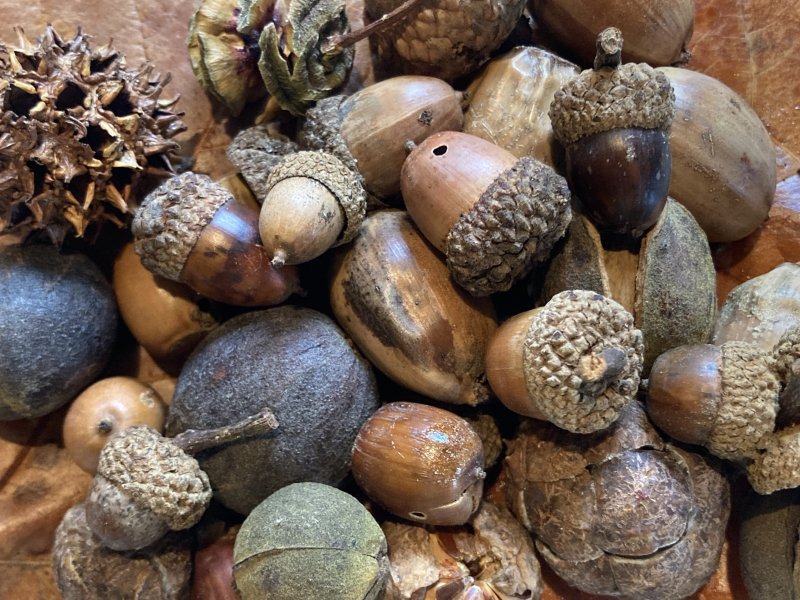Deciduous trees provide bountiful harvest for eastern gray squirrels
Cold autumn evenings bring forth brilliant reds and yellows as the leaves change daily across our Cape Region landscape. Dancing with the wind, I shuffle through a thick layer of leaves. On this quiet morning, clear, pinball-like sounds distinctly echo from the canopy to the forest floor. Squinting through the branches, I catch a glimpse of thumb-sized, brown projectiles intermittently careening and crashing to the ground. Two thoughts occur to me: “Should I be wearing a hard hat?” and “Wow, these squirrels are lucky this year!”
Plants broadcast or scatter their seeds from one place to another in a process called “dispersal.”
Each seed is designed to travel or be transported away from the parent plant to a potential site for growth. Common milkweed seeds are windblown or “anemochory,” while “ballochory” describes a mechanical tension that spring-releases spotted jewelweed seeds. Oak tree (Quercus sp.) acorns have the iconic “cap” over a smooth, rounded, tan, brown or black nut with a pointed tip, but each species has a specific size and shape. A healthy acorn leaves its cap attached to the branch and is “barochory,” using gravity to drop and roll. Perhaps an eastern gray squirrel (Sciurus carolinensis) will clip the acorn from a tree top, then carry and cache it underground for the winter. Seeds dispersed by animals are “zoochory.”
Gray squirrels are active year-round in mixed hardwood forests. Quick reflexes, agile movements and sharp claws enable their easy travel in a tree-dominant habitat. Squirrels are enthusiastic nut predators. With teeth that never stop growing, they chomp on fresh pine cones like corn on the cob or gnaw the spiky, woody exterior of a sweetgum (Liquidambar styraciflua) ball. Research indicates that squirrels are smart shoppers with good instincts. They count calories, determine protein content, weigh kernel mass and test shell strength. Squirrels also identify concentrations of tannins, which are preservatives, by licking each seed to taste its level of bitterness.
Using a keen sense of smell, touch and taste, they are able to compare nuts for immediate consumption and nuts with the “biggest bang for the buck” for winter storage. It’s a lot of work to lug that seed, so they want the best! Professor Stephanie Preston at the University of Michigan discovered and documented the “head flick,” showing that the squirrels were actually weighing the nut as they shook their heads. Seeds with small holes caused by insect infestation were lighter and discarded.
Which acorns make the grade? In a “mast” year, there are thousands of acorns, so a gray squirrel can be choosy. White oak (Quercus alba) acorns often sprout in the fall and have a mild bitter flavor from tannins, so these seeds are eaten on the spot. For optimal storage, northern red oak (Quercus ruba ) acorns are larger, resist insect invasion, have a high tannin concentration (which dissipates over time) and remain dormant until spring. The largest squirrels are also physically able to haul and store hickory and walnuts, which have the highest fat content enclosed in the toughest shells.
Gray squirrels practice “scatter hoarding,” hiding seeds over a broad area. A squirrel may have hundreds of caches of individual seeds in a territory. Each nut is buried about a quarter-inch below the surface. Squirrels are social and watch each other. Individuals also practice “deceptive caching” by pretending to bury a nut in a spot to throw off potential raiders!
How in the world do squirrels remember where they cached their food? What if snow covers the ground? In the PBS “Nature” documentary, “A Squirrel’s Guide to Success,” scientists at the University of Michigan suspect that caching behavior “requires so much brain power that it accounts for brain growth” during the nut-hoarding season. Each squirrel has an organized pantry—acorns in this plot, hickories to the right and larger nuts farther away. They have a strong memory or spatial map. Even under snow, squirrels are very successful using landmarks, such as rocks and trees, to orient to their cache and recover it.
Finally, remember those acorns they licked? They can also locate their acorns by the particular smell! As for the one or two seeds that are not recovered by spring, those acorns have the potential to germinate and grow. Oak trees are a keystone species, an ecosystem foundation that supports many species of insects, birds, herps (reptiles and amphibians) and mammals, including the eastern gray squirrel.























































